|
By Hanne Nielsen
Editor’s note: Ever wondered what life on the Frozen Continent is like? Hanne Nielsen gives us her perspective in this piece. If you’re curious to find out more you can visit her blog here.
Antarctica. The word conjures up images of vast expanses of ice, calving glacier fronts, diving penguins, and heroes bent double in a ferocious blizzard. Listen closely, and beyond the roaring gale the strains of a classical soundtrack will filter through. Violins and ice, accompanied by more shades of white than you know what to do with. White ice, white breath, white fingers, white light. Can you picture the scene? So could my 15 classmates and I, right up until the moment we touched down on the ice runway by Ross Island. As students of the University of Canterbury’s Postgraduate Certificate in Antarctic Studies, we were about to discover what Antarctica is really like.
Stepping off the plane, we were greeted by an expanse of white ice alright, but the only strains of music audible over the roar of the engines were the opening bars of the Beatles’ ‘Sergeant Pepper’s Lonely Heart Clubs Band.’ That put a different spin on the landscape, somehow. By the time the soundtrack had reached ‘Yellow Submarine’ we were pulling up outside Scott Base, the New Zealand Antarctic research station, and fumbling for our sunglasses as we spilled out onto the ice once more. Next it was time to learn about the dangers of said ice: before heading out to do field work, everyone must complete a course in survival training. Avoiding frostbite, recognising crevasses, and self-arrest techniques using an ice axe are all on the syllabus. Having been certified as safe, we packed up our food boxes and collected our camping gear, we were finally deemed ready to climb aboard the Hägglunds and head for our new home. Upon arriving at our campsite out on Windless Bight, our first task was to set up our tents. Made of yellow canvas, they are the same polar pyramid design as those used by the explorers of the Heroic Era some 100 years ago. Instead of pegs, the tents come with a skirt around the bottom. Burying the skirt under the snow anchors the shelter, and leads to nicely sculpted arm muscles in the process. Next it was time to construct the kitchen. Just like on a reality TV building show, we had a blank canvas, but in this case it consisted of a flat icy surface. To construct, we had to dig. This took some ingenuity, carving out benches for food preparation and to house our gas cookers. By the time we were done, we’d certainly earned our meal of dehydrated camping rations. Fieldwork formed an important part of our course, giving us a taste of the many strands of research currently being undertaken in the Antarctic. We turned our hands to many tasks, from doing a seal census, to digging a snow pit to examine the layers of ice, to undertaking a waste audit on the rubbish from Scott Base and checking all the recycling was correctly streamed. All waste must be removed from Antarctica, so reducing the use of packaging and making economic use of food and materials is an important concern. As we turned our attention to each task in turn, the long days seemed to bleed into one another, thanks to the 24-hour sunlight. In between times we were constantly cooking, clearing snowdrifts, and attempting to catch a few hours of sleep. In such a remote and chilly environment, staying alive is hard work. What did we take away from this field trip to the ends of the earth? An expanded sense of space, an appreciation for the logistics work that goes on behind the scenes to ensure that Antarctic science programmes can go ahead, and the conviction that there is so much more to Antarctica than panoramic shots and symphonic soundtracks. To find out more about the postgraduate Certificate in Antarctic Studies, visit http://www.anta.canterbury.ac.nz/courses/gcas/ 
About the author
Hanne Nielsen is a PhD student at the University of Tasmania, where she is looking at representations of Antarctica in advertising. She first visited Antarctica in 2011, and has been hooked on the continent ever since. In her various lives, Hanne has worked as an Antarctic tour guide, newspaper columnist, and biomedical engineering coder.
0 Comments
Your comment will be posted after it is approved.
Leave a Reply. |
LIFESTYLE BLOGRead our lifestyle advice, written exclusively for pre-professional women in science and engineering. From advice about fashion, work and family balance, self, wellness, and money, we've got you covered! |
The Scientista Foundation, Inc. All Rights Reserved © 2011-2021 | Based in NY | [email protected]
The Network for Pre-Professional Women in Science and Engineering
The Scientista Foundation is a registered 501(c)(3) -- Donate!
The Network for Pre-Professional Women in Science and Engineering
The Scientista Foundation is a registered 501(c)(3) -- Donate!


